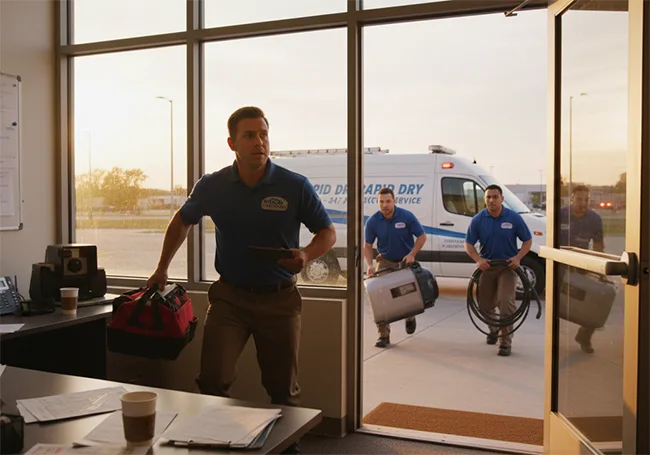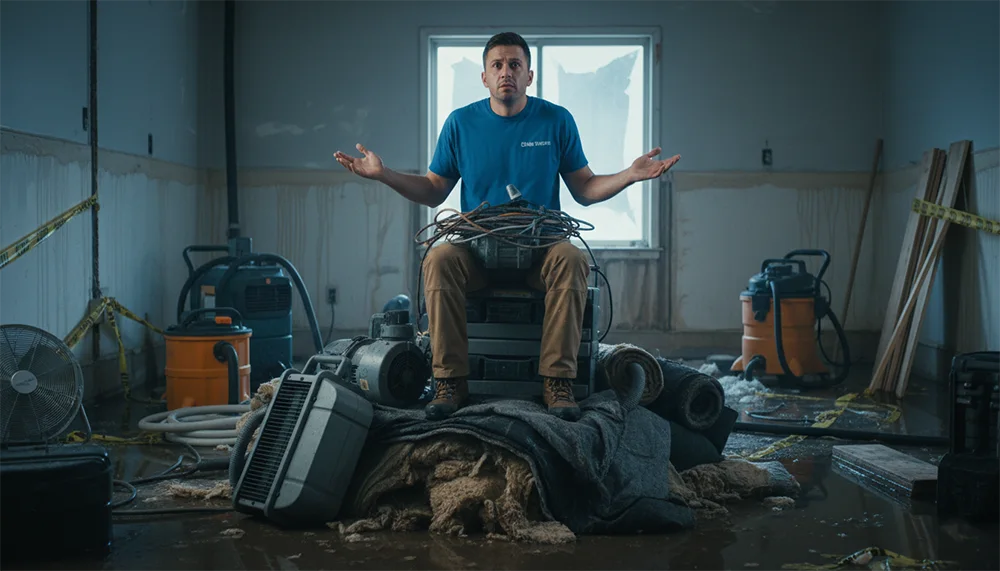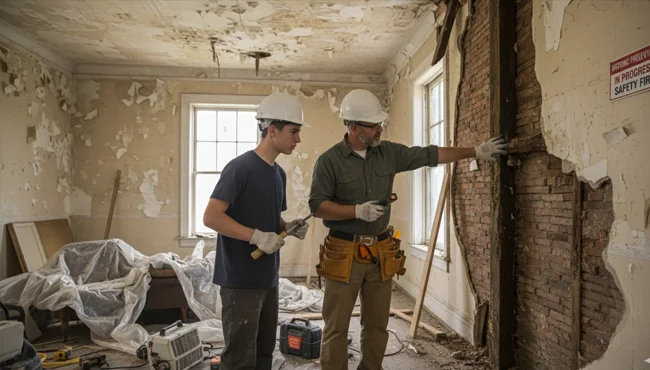Introduction: The 30-Second Judgement
You’ve won the job over the phone, but you can lose it in the driveway. The homeowner, standing on the curb watching your crew arrive, makes a crucial decision about your company in the first 30 seconds, and that decision is based almost entirely on your vehicle.
If your truck is messy, disorganized, or poorly maintained, it doesn’t matter how skilled your technicians are. The homeowner’s subconscious calculation is immediate and devastating: If they can’t manage their own vehicle, how can they manage my emergency?
The Restoration Truck Checklist is not just about inventory; it’s a foundational system that directly impacts your company’s Trust Score and overall profitability. A clean, organized vehicle signals a professional, process-driven operation, the exact kind of company homeowners and insurance adjusters want on site. This system is as critical as your moisture meters and your Xactimate knowledge. It is the visible embodiment of your commitment to excellence.
Why Your Truck is a Scorecard of Your Systems
In the knowledge base, the discussion about what to put on your truck quickly shifts from “what items” to “what system.” A truck checklist is a system that allows you to delegate. Without a non-negotiable checklist, you rely on the memory and diligence of each individual technician, leading to inconsistent execution and costly callbacks.
When your trucks are uniform and organized:
You Reduce Friction: Technicians don’t waste time searching for a tool or consumable, speeding up service and improving the overall client experience.
You Signal Authority: Professionalism is visible. Standardized, clean vehicles are a hallmark of high-tier operations, reinforcing the Authority component of the TACT framework.
You Mitigate Risk: A properly stocked vehicle means the crew has the necessary personal protective equipment (PPE), proper contracts, and safety gear, reducing job site liability.
The state of your truck is a direct reflection of your company’s internal operations. If the truck is chaos, the job is chaos. If the truck is organized, the job will follow suit.
The Non-Negotiable Vehicle Checklist
To standardize, you must categorize. Every restoration vehicle needs a standardized Restoration Truck Checklist broken down into three essential zones.
Zone 1: Documentation and Client Management
This zone contains everything needed to start the relationship correctly and secure the job, directly affecting your Trust Score.
- Work Authorization: Multiple copies of your attorney-reviewed, standardized work authorization. Never rely on the homeowner printing one out.
- Moisture Logs Tick Sheets: Clean copies of your standardized moisture logs and tick sheets. These documents are proof of work for the adjuster and must be meticulously maintained.
- PPE and Safety Forms: Accident reports, chemical safety data sheets (SDS), and basic safety checklists.
- Business Cards and Marketing Materials: A small, professional folder with company information and clear instructions on how to leave a Google review.
Zone 2: Essential Equipment and Consumables
This is the non-negotiable gear needed for every job, reducing the chance of a costly return trip.
- Diagnostic Tools: Moisture meters (pin and pinless), thermal imaging cameras, borescope (if applicable). These must be calibrated and working.
- Basic Safety Gear: First aid kit, N95 respirators, safety glasses, hard hats, gloves (various types), and floor protection for entry points.
- Consumables: Plastic sheeting, various tapes (duct, painters, poly), tie wraps, spray foam, air filters, and cleaning agents.
- Crew Appearance: Extra set of clean, branded shirts and a cleaning kit (Windex, rags) to wipe down the exterior of the truck before arrival.
Zone 3: Drying and Demo Ready-Pack
While major equipment (dehumidifiers, air movers) may be loaded based on the job, every truck needs a standard set of small, job-start necessities.
- Extraction Tools: Shop vac, extraction wand/attachment.
- Demo Tools: Basic hand tools (hammer, crowbar, screwdriver set), utility knife with extra blades, and small demo bags.
- Deodorizers/Antimicrobials: A standard, measured kit of biocides and deodorizers ready for immediate, proper application.
- Cleaning and Containment: Standardized zip-up door kits, temporary lighting, and extension cords clearly marked for restoration use.
Categorizing Your Cargo: The Three Zones of Efficiency
The physical organization of the truck should mirror these zones. The knowledge base highlights the importance of using systems like metal shelving or basket systems (like the Milwaukee system mentioned) to create a visual organization.
The Golden Rule of Organization: Everything must have a home. If a tool doesn’t have a specific designated space, it creates clutter, and clutter signals chaos.
- Driver’s Side/Cabinet: Dedicated to documentation and clean gear (Zone 1). This area should be the cleanest and easiest to access for client interactions.
- Middle Cargo Area: Dedicated to essential and frequently used consumables and tools (Zone 2). Often best served by customizable shelving or plastic bins labeled clearly.
- Passenger Side/Rear: Dedicated to dirty items, demo, and large, awkward tools (Zone 3). This area must be kept separate to prevent cross-contamination and keep the main cabin professional.
A properly systematized vehicle ensures that when the technician pulls up to a job, they are focused on the client’s crisis, not a frantic search for a missing item. This efficiency directly contributes to a smoother, faster job completion, which translates into better reviews and a higher Trust Score.
The Final Audit: Appearance and Trust
A truck checklist isn’t complete until you address the exterior and the crew’s personal appearance. This is the Authentic Presence aspect of the SVAC framework.
- Exterior Presentation: The vehicle must be clean, branded, and free of dirt or damage. A dirty, beat-up truck is the most common reason a homeowner chooses the competitor, even if your estimate is identical.
- Tire Audit: Check the tires, windshield, and fluid levels. Breakdowns are costly, unprofessional, and signal poor operational maintenance.
- Crew Uniformity: Ensure all crew members are wearing clean, branded uniforms. Cargo shorts and stained T-shirts are non-starters; they erode Trust instantly. The professionalism of your team’s look reflects the professionalism of your job execution.
Your fleet is a mobile billboard for your company’s standards. If you are serious about scaling a restoration business and attracting high-margin work, you must adopt a zero-tolerance policy for sloppy vehicle presentation.
Are you treating your trucks like necessary clutter, or like the powerful, Trust-building asset that they are?
Frequently Asked Questions (FAQ)
Responsibility should be dual. The lead technician on that vehicle is accountable for execution, but the Office Manager or a dedicated Logistics Manager should audit the checklist randomly, daily, or weekly. This ensures the system is enforced, not just completed as a formality.
Cleanliness is the non-negotiable foundation of Trust. Branding is the identifier. A clean, unbranded truck is better than a dirty, fully wrapped truck. The best scenario is a clean, well-branded truck that reinforces the professionalism the client sees upon arrival.
A basic restocking (consumables, fuel, paperwork) should happen at the end of every day. A full inventory audit (checking tool functionality, checking for damage) should happen weekly. A poorly stocked truck leads to emergency runs and wasted time, destroying efficiency.
Yes. In competitive bidding situations where price is similar, the visual cues of professionalism (truck appearance, crew uniform, quality of initial paperwork) are often the deciding factor for a homeowner who needs to feel safe and confident in their choice.





